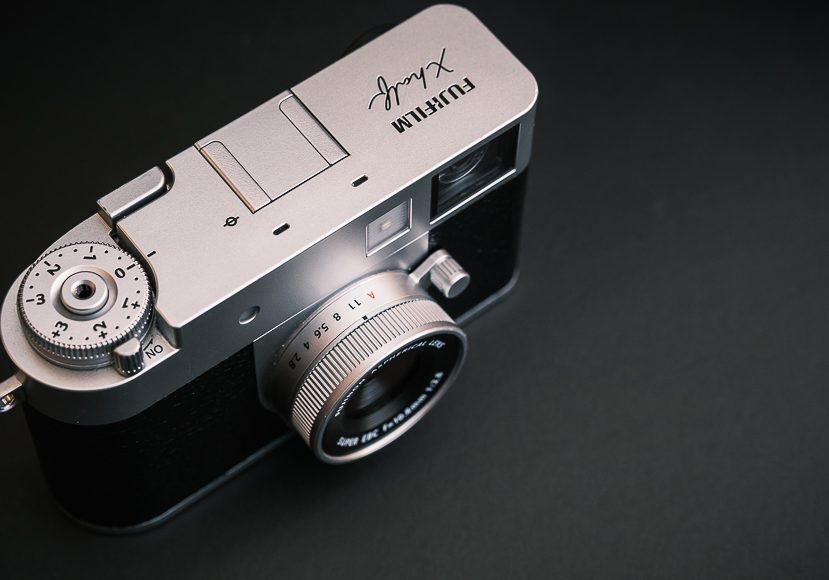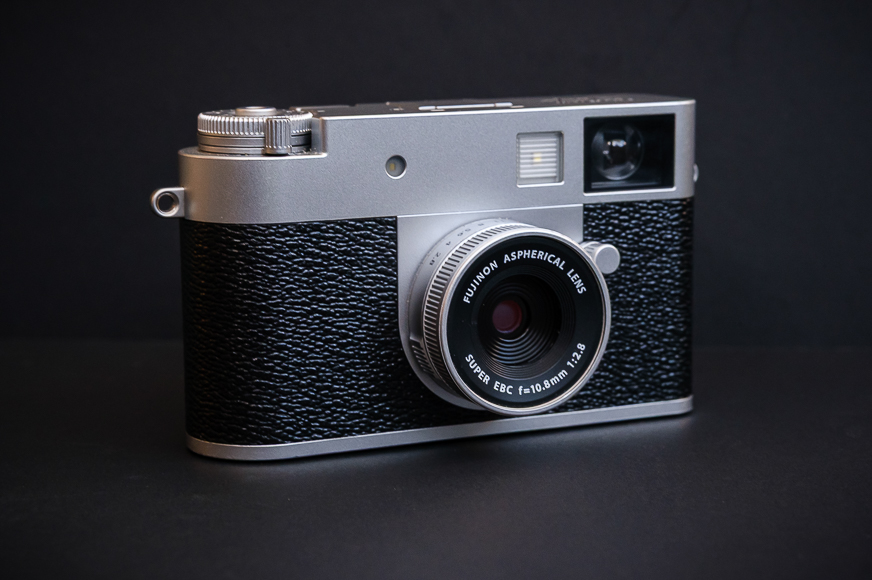
Fujifilm X Half Frame – Gimmick Or Genius?
In our Fujifilm X Half digital camera review, we discover whether the new influencer-savvy offering isn't half bad or a bridge too far.
Camera Reviews | Fujifilm Camera Reviews | Photography Gear Reviews | By Greg Cromie | Last Updated: June 2, 2025
Shotkit may earn a commission on affiliate links. Learn more.
In our Fujifilm X Half digital camera review, we discover whether this new influencer-savvy offering is a gimmick or a stroke of genius.
The Fujifilm X Half (X-HF1) is a digital mirrorless camera like no other. Fujifilm is on a streak of breaking new ground with unique digital camera models such as the GFX100RF.
Fujifilm’s X Half is a pocketable, compact camera that borrows heavily from the Fujica Half 35mm half-frame film camera from the 1960s.

Playful camera with unexpected features and a vintage design that brings film-era fun to the digital world.
In many ways, most surprisingly, the X-HF1 straddles the boundary between current-gen tech and old-school film photography methodology and processes.
Make no mistake: the X Half is designed to get younger creatives off their smartphones and into the world of mirrorless cameras. It’s a bridging product that offers familiar creative tools and a new way to create images.
Read on to learn more about half-frame history and all that the Fujifilm X Half digital camera gets right and wrong.
Fujifilm X Half Specs
- Compact and lightweight
- Ideal influencer camera
- Inspired retro design and application
- Offers a unique and surprising blend of “film” and digital
- Fujifilm’s powerhouse X Processor 5
- 13 film simulations
- Built-in flash/LED lamp
- Exceptional battery life
- Gimmicky features until you understand them
- Film Camera Mode requires a smartphone app
- Lack of a hot shoe
- Clunky and fiddly lens interface
- Unresponsive touch screen(s)
- Sluggish autofocus performance
- Sensor – 1-inch Half-Frame CMOS Sensor – 17.74MP
- Processor – X Processor 5
- Fixed Lens – 10.8mm f/2.8 (32mm full frame equivalent)
- Maximum resolution – 7296 x 4864
- Photo ISO – Auto 200-12,800
- Video ISO – Auto 200-12,800
- Video – Full HD 24p
- Viewfinder – Reverse Galilean optical viewfinder (90% coverage)
- LCD – 2.4″ 0.92 Million Dot Fixed Vertical Touchscreen Color LCD
- Stabilization – None
- Focus – TTL contrast AF
- Max Shutter – 1/2000 MS
- Storage – SD UHS-I Card Slot
- USB – USB Type-C 2.0
- Battery Life – NP-W126 (880 frames)
- Weight – 8.5oz (240g) with battery and memory card
- Dimensions – 4.16 x 2.53 x 1.8″ (105.8 x 64.3 x 45.8mm)
History of the Half-Frame

Fujica (Fujifilm) Half 35mm Film Camera
The origins of the half-frame film camera date back to the 1960s. Japanese consumers were seeking smaller and more affordable 35mm film cameras.
As a result, leading camera manufacturers settled on the 35mm half-frame format.
Given photography’s rising popularity, brands such as Olympus, Ricoh, Konica, Canon, Yashica, and, of course, Fujifilm developed a series of half-frame cameras.
These cameras were typically much smaller and more compact than the era’s standard rangefinder-style full-frame 35mm bodies.
While most half-frame cameras of the time featured fixed lenses, courageous brands like Olympus developed half-frame bodies with interchangeable lens systems.
Not to be outdone, Fujifilm released the Fujica Half film camera in 1963.
The Fujica Half offered a lightweight 18.1oz (514g) compact body, a fixed 28mm f/2.8 (40mm full-frame equivalent) lens, selenium light metering, and a Seikosha-L shutter mechanism.
The original Fujica Half and the new digital Fujifilm X Half share many visual similarities.
Half-frame film cameras were used through the 1960s, 1970s, and early 1980s before disappearing due to declining popularity and the demand for higher-resolution images.
However, in 2024, Ricoh reignited the half-frame revolution and revealed an all-new 35mm half-frame film camera with the Pentax 17. As with earlier half-frame cameras, it takes a 35mm film (which also began as a half-frame of 70mm cinematic film).
When an image is captured with a half-frame film camera, and the shutter opens, only half of the film frame is exposed. When the film is wound forward for the next shot, the second half of that 35mm frame is used.
A 36-frame roll of 35mm film will produce 72 half-frame images. A standard 35mm film frame measures 24×36mm. Half-frame film cameras capture an image area of 18×24mm—half the size and half the resolution.
Shooting with a half-frame camera requires some mental acrobatics. Because the frame is split vertically (half-frame cameras were also called split-frame), the portrait/landscape orientations are reversed.
To capture a landscape shot, you rotate the camera 90º as though you were shooting a portrait. To capture a portrait shot, you hold the camera normally as though you were capturing a landscape.
If you’ve never shot with a half-frame camera, the experience takes a little getting used to.
Build & Appearance

When I first gazed upon the tiny Fujifilm X Half digital mirrorless camera, I wondered what the #%*! Fujifilm had created.
Having recently tested and reviewed the powerful and unique (yet consumer-polarizing) GFX100RF large-format digital camera, I briefly questioned whether Fujifilm had gone too far this time!
I much prefer Fujifilm’s smaller and lighter mirrorless cameras over the larger flagship models, but the X Half is so small I was shocked by its toy-like appearance.
Never one to judge a book by its cover, I took the Fujifilm X Half out of the box to inspect it thoroughly.
There’s no denying that the Fujifilm X-HF1 is a tiny, pocketable digital camera; however, it retains visual balance because key features are proportional to its overall size.
Available in black, silver, and charcoal, the camera measures 4.16 x 2.53 x 1.8″ (105.8 x 64.3 x 45mm) and weighs 8.5oz (240g), making it one of Fujifilm’s smallest and lightest cameras in recent years.
Despite its toy-like appearance (you get over that after a while), the X Half has a nice heft to it, but it’s a little top-heavy and, as a result, feels unbalanced.
Building on the Fujica Half’s heritage, Fujifilm has done an amazing job styling the new X Half to appear like a film camera.

Starting with the front, the X Half features a fixed 10.8mm f/2.8 (32mm full-frame equivalent) Fujinon lens with a manual focus ring and an aperture ring with a small control post.
The tiny lens has a 1.3″ (33mm) diameter, and it protrudes from the camera body by 0.51″ (13mm). It also comes with a rubber lens cap. Yet it still fits 6 elements in 5 groups (includes 3 aspherical elements).
The front of the X Half also features a sensor for the light meter, a flash/LED lamp, and the front square element for the optical viewfinder. Yes, the Fujifilm Half has no electric viewfinder; yet another callback to its Fujica heritage.
The left side of the X-HF1 features a strap lug, flash/LED on off switch, and a small panel hiding the USB-C port for charging and connecting accessories. The camera’s right side is bare except for the second camera strap lug.

Fujifilm has kept the top plate as minimal as the rest of the camera. It features a single exposure compensation dial supporting the shutter button in its centre.
The On/Off toggle is at the front of the dial. When switched to On, it triggers the film wind lever to pop out—more on that later.
The top plate also features a cold-shoe with a neat cover and an engraved Fujifilm X Half logo.
And the rear of the Fujifilm X-HF1 is like no other camera – Fujifilm or otherwise.

The X Half features a portrait-oriented half-screen rather than a traditional 3″ landscape-oriented touch screen. The rear also features a small sub-screen with touch controls to support film simulation options and other features.
Sticking to the Fujica Half influence, the new X Half only features a single Play (image, video playback) button and a switch to toggle between film and stills capture.
As mentioned, the X Half lacks an EVF and instead relies on a simple optical viewfinder. The viewfinder still features a sensor that switches off the main and sub screens when you bring the camera to your eye.
Finally, the X-HF1’s base features a standard tripod screw thread and a simple latched door that stores the NP-W126 battery and SD card.

Overall, the Fujifilm X Half digital camera has good build quality, even though it uses a lot of plastic. It isn’t as solid or robust as other Fujifilm X Series or GFX bodies, but it holds up.
As for appearance, I can see many being fooled and equally surprised to learn that it’s not an old-school retro film camera but, in fact, a unique and surprising digital mirrorless camera.
Hats off to Fujifilm for designing a current-gen digital camera that borrows so heavily from the original Fujica Half from the 1960s.
Ergonomics & Handling

The Fujifilm X Half is a teeny weeny digital mirrorless camera. It’s smaller than the Fujifilm X-M5—and that’s a tiny camera!
Unlike other digital bodies, there’s no protruding front grip or rear thumb bump. As a result, you’re relying purely on the pressure of your grip to keep it in your hand.
Where the left side of the camera body is squared off, the right side is rounded to offer greater comfort.
However, at the grip, the camera is only 1.18″ (30mm) thick and 2.53″ (64.3mm) high – not a lot of real estate there. The textured body wrap makes little difference to grip.

As mentioned earlier, the fixed lens measures 1.3″ (33mm) in diameter by 0.51″ (13mm) deep. The coin-size lens boasts manual focus and aperture control rings.
While the aperture ring features a handy level, the glide between aperture stops is clunky and not refined. It takes a lot of getting used to.
Given that the Fujifilm X-HF1 features a single Play button, all other menu controls are accessed via the main and sub touch screens. Taps and swipes are the order of the day.
While I appreciate Fujifilm sticking to a retro control layout, the responsiveness of both touch screens is hit and miss at best. Sometimes, I had to tap a function two to three times before the screen registered my input.

Here’s a quick guide to the touch screen inputs:
- Main Screen: Swiping down opens the Pairing (to a smartphone) and Film Camera Mode menus.
- Main Screen: Swiping up opens the main menu to access focus mode, shooting mode, file size, face/eye AF settings, and more.
- Main Screen: Swiping right to left opens a quick-access menu for Exposure Mode, Image Size, and Self Timer.
- Main Screen: Swiping left to right opens the Film Simulation and Filters menu.
- Main Screen: In stills or movie mode, you can tap the main screen to control Shutter Speed and ISO.
- Sub Screen: In the quick access menu, you can use the sub screen to select stills or movie modes.
- Sub Screen: The sub screen displays up to 13 Fujifilm Film Simulation modes, which can be selected by swiping the screen up and down.
In keeping with the Fujica Half design, the new X Half features an optical viewfinder that passes through the camera body. I found the clarity and viewable area limited, and there’s no way to adjust the view to suit those of us who are optically challenged.
One of the most unique features of the Fujifilm X Half is the inclusion of the film wind lever. In a film camera, the lever would wind the film forward either a full frame or a half frame, as in the case of the OG Fujica Half.

In this case, the lever pops out whenever the camera is powered on. Fujifilm has employed the lever for a handful of fun features that make the most of the half-frame outcomes. Here’s a quick look at how the lever works:
- Pushing the lever in displays the last still shot on the LCD.
- Winding the lever after taking a shot activates dual image mode, where you can take a second shot to create a square frame with the two images side by side.
- Winding the lever advances the “film” in Film Camera Mode – more on that in a minute.
Handling the Fujifilm X Half is a contradictory experience. It’s compact and lightweight but far less robust than a typical Fujifilm X camera.
Its minimalist external control layout removes distraction, yet the touch interface isn’t as effective as it should be.
The optical viewfinder is a wonderful throwback to retro film cameras, but it offers a less-than-ideal view of the scene.
There’s a compromise for every good, surprising, or unique feature the Fujifilm X Half offers.
Focus Performance
Despite the Fujifilm X Half’s initial appeal and appearance, it offers good focus features and options thanks to the X Processor 5, the same processor found on Fujifilm’s flagship models.
The X Half offers Manual, Continuous, and Single AF focus modes and a comprehensive range of Eye and Face Autofocus options. Unfortunately, it doesn’t detect animals or subjects.
Regarding autofocus performance, I found the X-HF1 sluggish in acquiring focus, especially in low-light settings. I imagine that’s more about the quality of the motors driving the lens alignment to achieve focus.
In better light, the X Half was much more responsive and quicker to acquire sharp focus. Face and eye detection were acceptable, but nowhere near as “sticky” as other X Series cameras with the X Processor 5.
Focusing performance isn’t a strong suit for the little pocketable camera. But again, it’s not a pro-grade tool to begin with.
Low Light Performance

Another surprising addition to the Fujifilm X Half is a multipurpose flash for photography and an LED lamp for video.
Given that the X-HF1 is targeting a younger, influencer-savvy market, including a reasonable LED lamp is a clever design and marketing choice.
It’s also worth reminding you that the shoe on top of the camera is not designed to connect to external flash units. It’s cold and lifeless.
The X Half features an auto and adjustable ISO range of up to 12,800 for stills and video. It’s not groundbreaking, but it’s a welcome addition.
As mentioned, focus performance is noticeably slower in low-light settings compared to full daylight.
Considering that the camera only packs a tiny, low-resolution sensor, heavy grain is noticeable, and given that the files are JPEG only, it’s harder to clean up in post-production.
Image Quality

Before we talk about image quality, let’s get some perspective. The Fujifilm X-HF1 is NOT a professional or even enthusiast-level digital camera. It’s not for everyone.
It only has a 1-inch Half-Frame CMOS image sensor – it’s half a sensor! The sum of all parts of any digital camera determines image quality.
While it packs a powerful X Processor 5, the fixed 10.8mm f/2.8 (32mm full-frame equivalent) isn’t an optical masterclass.
Given the sensor size and resolution, the lens assembly and quality, and the camera’s focus performance, image quality is good. It’s certainly good enough to grab some likes and shares while viewed on social media pages from a smartphone screen.
It’s essential to remember that the Fujifilm X-HF1 only shoots JPEG-quality images in three file size options: L (18MP), M (6MP), and S (2MP).
Given that Fujifilm wants you to pair this camera with the app, they don’t want to complicate the transfer process by adding in-camera RAW to JPEG file conversion.
It’s also clear that Fujifilm doesn’t intend for you to edit these files in editing software—you apply the film simulation and get the exposure right in-camera, old school.
You can easily create 2-in-1 images in-camera by combining vertical still images and movies with a winding up of the “frame advance lever”.
Speaking of simulations, the X-HF1 features 13 of Fujifilm’s best film simulations, along with a range of fun filter effects.
As for video performance and output, the X Half records Full HD at up to 24p. It captures stereo audio via the internal microphones or via an external mic connected to the USB-C port via an adaptor dongle.
Fujifilm X Half Sample Images
Here are some sample images I took using the new Fujifilm X Half digital mirrorless camera.








Overall Performance
Overall, the Fujifilm X Half, aka the X-HF1 half-frame digital camera, is a mixed bag of performance and outcomes.
On the one hand, the X-HF1 packs a powerful and responsive processor. However, on the other hand, that powerhouse of a chip is competing with a low-resolution image sensor and a small and relatively basic lens assembly.
The lens rings are fiddly for my bigger, older hands, and the touchscreen(s) lack responsiveness. It’s frustrating having to swipe two or three times to get a response before having to do so again to select the next menu step.
While these gripes need to be addressed in a Mark II version, I have to applaud Fujifilm’s efforts in replicating the look, feel, and even experience of classics like the Fujica Half.
Fujifilm X Half Film Camera Mode

Fujifilm X Half Film Camera Mode Infographic
One of the most intriguing additions to the Fujifilm X Half is the inclusion of a Film Camera Mode. Is it a gimmick or is it genius?
No, the X Half doesn’t also shoot film, but it does a lot to replicate the half-frame film photography experience once enjoyed with the Fujica Half.
A simple downward swipe of the main screen reveals the Pairing and Film Camera Mode menu options. You must first pair your smartphone with the camera.
Film Camera Mode treats the camera and user experience like there’s a roll of film inserted.
Selecting Film Camera Mode opens an Initial Setup menu where you select the number of shots (36, 54, or 72) on the film, if you wish to have your images date-stamped, and the Exposure Mode you desire.

Once you press start, the main LCD presents a retro-inspired graphic that replicates simple calculator-style LCD screen technology.
The screen displays the date, how many frames you’ve already captured, and an AF/MF switch. If MF is selected, you can adjust the focus distance slider at the bottom of the screen. The sub screen displays the Fujifilm film simulation in use.
While in Film Camera Mode, you can’t access or even view the images you’ve captured, like using a traditional Fujica film camera. You also can’t stop Film Camera Mode midway through a “roll of film”.
The only way to view your images is to first transfer the files to your smartphone via the dedicated Fujifilm app. The app acts like a digital film development and processing lab to reveal the images after the fact.
From there, it’s simple to further edit your images and share them instantly via social media.
It’s a wonderful throwback to film photography, but it can be a little frustrating not being able to view the images in-camera.
However, true to Fujifilm’s ethos, shooting without knowing the outcomes does invoke wonder and delight. There’s something special about being in the moment and working with the camera and your growing knowledge of the exposure triangle to create an image.
I just can’t tell if it’s a gimmick or a stroke of genius.
How I Tested the Fujifilm X-HF1

I tested the Fujifilm X Half digital mirrorless camera over two weeks before the official launch.
I was lucky enough to be one of the first in Australia to test the new camera.
With that in mind, I used the Fujifilm X-HF1 in and around my home and while out and about on street walks in my local neighbourhood.
Unfortunately, I wasn’t able to test the film camera mode fully when I wrote this review – I didn’t have access to the new app.
To use Film Camera Mode, you must have the Fujifilm smartphone app, which acts as the “development lab” that processes your “films”. As a result, I can’t accurately comment on the app or the overall process.
I should also point out that when downloading all images into Adobe Lightroom, the “film roll” images were not available.
Value for Money

The Fujifilm X Half mirrorless camera is intended as a bridging camera for those who wish to transition from smartphone photography to digital mirrorless photography.
A bridging camera offers a safe stepping stone for those straddling a technological boundary. In this case, jumping from the smartphone we all carry to a more serious photography and videography device.
It’s not Fujifilm’s first attempt at enticing younger visual creatives away from their phones with an affordable and fun device. The Fujifilm X-T100, X-T200, and later X-A models, such as the X-A7, boasted features tailored to smartphone shooters.
The new Fujifilm X Half digital half-frame camera is set to retail for around AUD$1,350.00 – check your local region for retail pricing.
For comparison, the Fujifilm X100VI 40MP fixed lens compact retails for around US$1,600, and the compact Fujifilm X-M5 powerhouse with a kit XC 15-45mm f/3.5-5.6 lens retails for around US$900.
AUD $1,350 equates to approximately US$870.00, making the Fujifilm X Half around the same price as the significantly better X-M5 with a kit lens.
Given the above, it’s hard to recommend the Fujifilm X-Half as good value.
Granted, it offers a unique experience and is likely targeting a slightly different demographic than the X-M5. However, when comparing apples (X Half video and image quality) with apples (X-M5 video and image quality), the latter wins the day!
Fujifilm X Half Review | Conclusion
The Fujifilm X Half is a surprising entry in the Fujifilm fleet of digital mirrorless cameras. It’s a fascinating blend of genius design concepts and gimmicky features – that’s not a bad thing.
Given the brand’s current focus on younger influencers and creators, perhaps it’s not surprising to see a camera tailored to new photographers.
The X Half is an ideal travel and experience camera that offers good image quality and reasonable video recording. Plus, its seamless integration with smartphones enables instant access and sharing of content on social media.
Having said that, Fujifilm must address a few missed opportunities in a Gen-2 version of the digital half-frame concept. Improved lens quality, autofocus performance, and an improved touch interface would top the list.
As it stands, the Fujifilm X Half is a great entry-level camera with some fun and unique visual creative tools. It’s an ideal bridging camera designed to entice smartphone photographers back into digital camera photography.
However, its retail price makes it a tough camera to recommend.
If a newbie photographer approached me and asked what the best Fujifilm camera for photography and videography is, that’s under US$1,000.00, the X-M5 would be my instant answer.
As a result, Fujifilm missed an opportunity to deliver a unique product at an affordable price for its intended ‘new-to-photography’ market.






